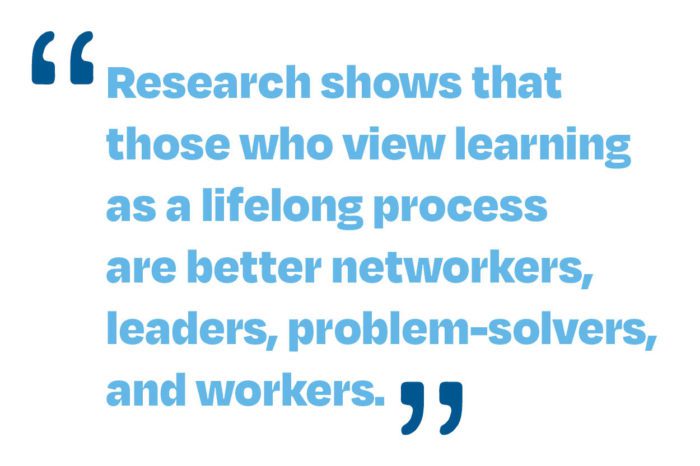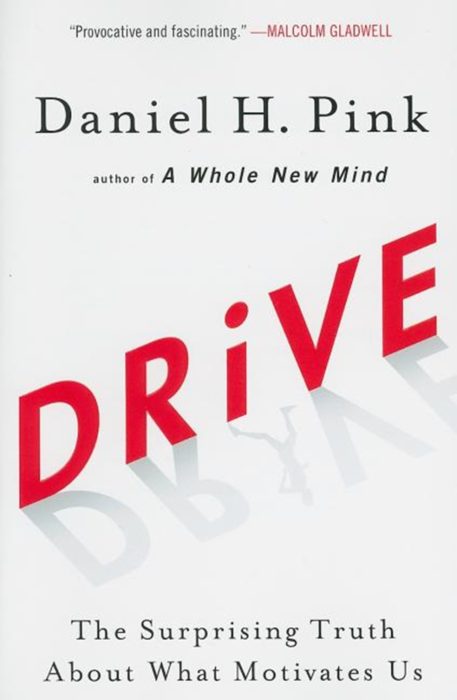Some people view their jobs as a place where they clock in, fulfill their duties, clock out, and go home — it pays the bills. But in reality, it should be a place where employees learn, grow, and become better people overall. And learning and growing aren’t just beneficial for employees’ well-being; their education will also benefit your business’s bottom line. The importance of training in the workplace is that it promotes growth for everyone involved.

Shaun Buck, our CEO, has a simple trick to identify which team members are ready and willing to grow. These are the employees who will push our company forward in all the right ways. According to Shaun, the key marker of an employee ready to shine is what’s right on their desk. No, he’s not looking for leftover banana peels or evidence that they’ve been sleeping at their desk to cram in more work. The real evidence? Continuing education materials.
But it’s more than just having a stack of books lying around. These team members must also actively seek out new opportunities to grow and learn. He says the team members who go the farthest are the ones hungry enough for knowledge to make themselves known.
Shaun isn’t alone. Companies around the world recognize not only the abstract value of continued education but also its direct effect on their bottom line. Why is this? Research shows that those who view learning as a lifelong process are better networkers, leaders, problem-solvers, and workers.

Continuing Education = Motivated Employees
In his book “Drive: The Surprising Truth About What Motivates Us,” author Daniel H. Pink writes that in order for human beings to feel connected to their lives, fulfilled, and motivated, they need 3 things: autonomy, mastery, and purpose. Education — formal or informal — is the single key that unlocks all 3. This is the importance of training in the workplace. It gives your team the key to unlocking their full potential, professionally and personally.

Most Americans spend the first 22 years of their lives learning. Then, they go to work and forget all about it. According to Pew Research, about 23% of Americans are not even reading books! How do we change this and create a smarter, more resourceful workforce? Why would we want to?
The American Society for Training and Development (ASTD) conducted a study of 540 U.S. corporations. According to the ASTD, groups that spent more on training had 37% higher gross profit per employee than groups that spent the bare minimum. Groups with the highest success spent about 6% of their annual payroll budget on training and continuing education.
Not only that, but the study also indicated that firms that invest $1,500 in training per employee, compared to those that spend $125 per employee, experience an average of 24% higher gross profit margins and 218% higher revenue per employee.
An Educated Workforce Is A Happy One.
Of course, we want our employees to be motivated at work, and we want them to view their jobs with us as more than a perpetual time clock or paycheck. Some business owners attempt to tackle this issue with holiday parties, free lunches, or break incentives, but the truth is that these are short-term solutions to address employee dissatisfaction — they’re one-time use only.
And if you’re not worried about how happy your employees are with their jobs, you should be. According to a Gallup poll, only 21% of employees actually feel engaged in their work, and 33% “don’t find their work meaningful, don’t think their lives are going well, or don’t feel hopeful about their future.” The poll also reports that phrases like “living for the weekend,” “watching the clock tick,” and “work is just a paycheck” dominated its responses.
Every one of these phrases and statistics is a major red flag for employers because they scream “churn.” Employees who are unhappy and unfulfilled are more likely to quit, leaving you out of a workforce.
This is where continued education comes to the rescue, and a study by LinkedIn highlights the importance of training in the workplace as it relates to employee happiness and satisfaction. The study found that employees who received learning opportunities were “47% less likely to be stressed, 39% more likely to feel productive and successful, 23% more ready to take on additional responsibilities, and 21% more likely to feel confident and happy. And the more you learn, the happier you become.”

And you may be wondering why something subjective like “happiness” matters at work. But how good your employees feel about themselves and their lives immensely impacts their productivity; employees who feel happier are more likely to put forth their best effort and are less likely to miss work.
The only remaining question is how to get your team on board. Here are some quick suggestions.
Lead By Example.
Shaun’s dedication to knowledge is contagious. He encourages employees to share in this knowledge by distributing our company newsletter and “weekend reading” emails to the team. If you have these tools at your disposal, consider sending them out to your team as quick, easily digestible ways for your employees to absorb your knowledge.
But there are other ways you can lead by example. Starting a book club or learning hour that you also attend is a great start. Even if no one else shows up at first, inviting your employees to learn alongside you shows your interest in growing yourself. Don’t enter the training as their teacher, but as their classmate. Showing your team that you’re also trying to learn new things makes training seem less like a requirement and more like an activity anyone can participate in and learn from — even their boss.
Also, if you have read or seen any interesting books, documentaries, or MasterClasses lately, talk to your team about them! You don’t even have to ask them to read or watch them, but just share with them that you’re also trying to grow as a professional.
Make Continuing Education Easy.
Not all extended education has to be expensive or even lengthy. At Newsletter Pro, if a team member wants to read a book that has to do with their position or growth as a leader, craftsman, or employee, they can! All they have to do is submit a request to our executive assistant — no hoops, no mess, and no reimbursement wait.
Additionally, our team members can access subscriptions to publications like Harvard Business Review and The Wall Street Journal. They can also log on to various training and continuing education online platforms. This includes LinkedIn Learning, a highly robust platform for training of all types. We also make it easy for our team members to explore conference and workshop options by offering to meet them halfway on costs. When they show an investment in their future and ours, we are willing to invest in that, too.

If you don’t know what training services you should offer, ask your team! We offer access to Harvard Business Review and The Wall Street Journal because those are the sources our team prefers to learn from most, but yours may be different. Next time you meet with employees one-on-one, in a meeting, or even virtually, ask them what they’re interested in learning about and from where.
And, going back to the happiness factor, checking in with your employees this way increases their feeling of belonging. It turns out that 39% of individuals feel the highest levels of belonging at work when someone checks in with them. Business leaders can significantly improve performance and engagement by asking what their employees want instead of randomly assigning training or education courses.
Another way to simplify education while maintaining the importance of training in the workplace is to provide your team some autonomy in how they complete it. Often, scheduled mandatory training can disrupt schedules and create that “this could have been said in an email” feeling.
At Newsletter Pro, our learning opportunities are self-paced, and employees have a wide window to participate in them. This way, our team can learn something new at the time, place, and pace they feel most comfortable with. The idea of training isn’t to check a box but to actually help your team grow and improve beyond where they are now.
Make Them The Teachers.
Task high-performing members of your team with independent research. Have them report their findings to the rest of the team. When team members are spurred to find and share new ideas, you’re left with highly educated employees. Plus, the “teacher” will learn with a sense of purpose. This is called The Protege Effect.

Relaying new information to others is scientifically proven to increase retention and memory, and studies show that when someone learns something to teach it later, they understand it more deeply. It also gives the learner an insight into what they don’t know. By allowing your high-performing team members to conduct trainings, they can better target your team’s most significant growth opportunities. Who better understands where others in their department can improve than a member? Someone who works in their area of research daily can identify pieces of information they think would especially benefit their team because they didn’t already know it.
A half-century ago, a business might have survived solely with its on-hand knowledge. But in today’s competitive world, the only way to the top is through a continuous and concerted effort to learn, innovate, and advance.
So, why focus only on your own education when you can exponentially multiply the knowledge, purpose, and power of your employees? Empowered employees lead to increased productivity, stronger client relationships, and satisfaction.
Want to learn more about our business journey and the practices that make Newsletter Pro successful? Fill out the form below to request your free copy of our founder’s book, “The Ultimate Guide to Newsletters.”






